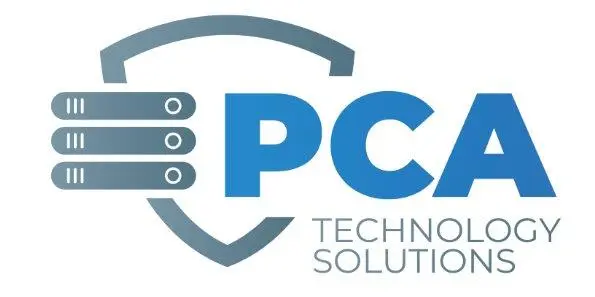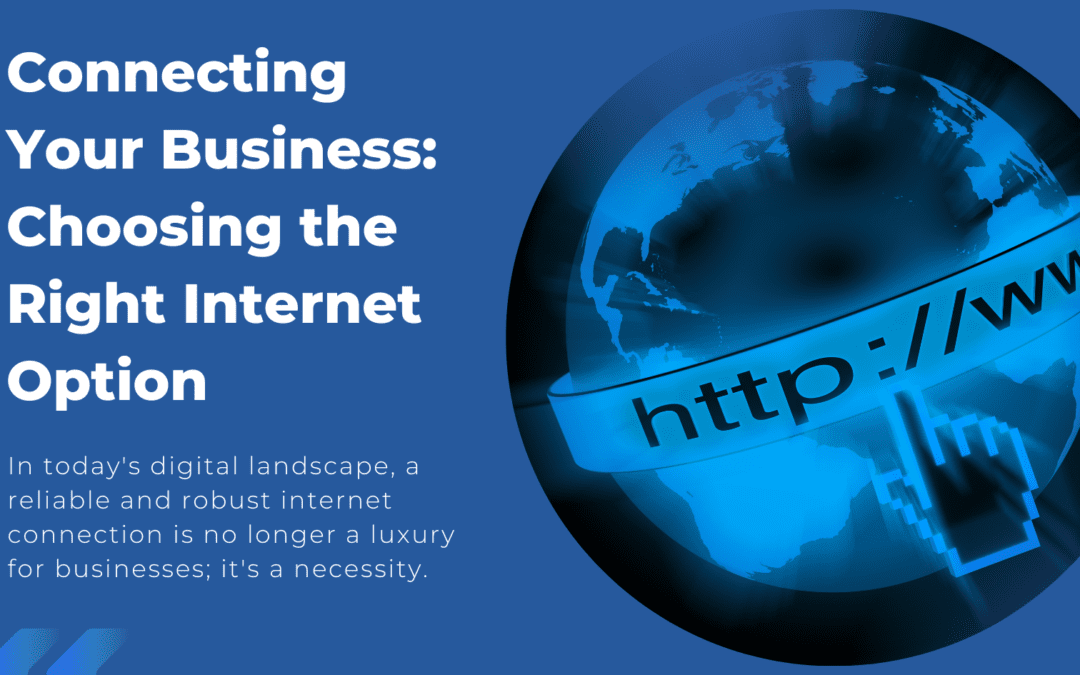Connecting Your Business: Choosing the Right Internet Option
In today’s digital landscape, a reliable and robust internet connection is no longer a luxury for businesses; it’s a necessity.
But with so many options and providers available, choosing the right internet service can feel overwhelming. This blog aims to demystify the different types of internet connections offered by top providers in the United States, helping you make an informed decision for your business needs.
The internet is something we all use every single day.
But what is it really? How does it work? Why does it sometimes not work like it does at other times?


I like to compare the internet to a road, or a highway, or even a water pipe. When we drive down the road during the middle of the day and there aren’t many cars using that road, then it’s easy to go as fast as we want (before the police tell us otherwise!).
However, when it’s Friday at 4 pm before a holiday weekend, then we all know to expect to be stuck in traffic and that we won’t be able to go above 25 mph, instead of our usual 70 mph on the same road, right?
Same road, different amount of traffic, different speed ability.
This is the same concept of how our internet “slows down” when there is a lot of “traffic” on the line – lots of users trying to use the same line.
Have you ever tried to use your phone at a college football game? Or at a large concert? Too many people in one area overload the cell tower’s capacity and no one can get any speed at all. The internet pipe’s capacity is maxed out.
A common misconception is that internet speed is everything. That is only sometimes the case. If we had a Lamborghini, would we want to drive it fast down a dirt road? No, definitely not!
Do you have a spare tire in your vehicle? If you do, ask yourself why. This concept is exactly why redundant internet connectivity is helpful to have in place for your business.
We also have solutions called Software Defined Wide Area Networks, AKA: SD-WAN, which is the technology of using multiple internet connections and routing traffic accordingly based on the awareness of the connection.
Think of this like using a map on your phone to get where you are going, and when there is an accident on the road the map reroutes you to an alternative road, saving you time and money, and you’re back to business as usual.
Oh, and to go back to my water pipe comparison. You wouldn’t see a firefighter connecting a garden hose to a fire hydrant, would you?
If you have a fire hydrant (VERY FAST INTERNET), we size that hose correctly for you to utilize the water coming out of the hydrant in the best way for your business.

Determining the exact percentage of SMBs with inadequate internet service is tricky, as factors like “right” and “needs” can vary greatly based on individual businesses.
However, we can explore some data and research to paint a picture:
Limited Access:
-
- 8% of US small businesses lack access to broadband that meets their needs, according to surveys by the National Federation of Independent Business and Google. This points to a portion of SMBs facing a fundamental access issue, rather than simply choosing the wrong plan.
- Rural areas often have limited internet options, leaving SMBs with fewer choices and potentially suboptimal options compared to urban counterparts.
Mismatched Plans:
-
- Many SMBs might be unknowingly overpaying or under specced, either due to lack of awareness or difficulty navigating complex service options. Research suggests 44% of businesses aren’t sure if their current plan is the right fit.
- Changing business needs over time can also lead to an internet plan becoming unsuitable. A business that suddenly starts using cloud-based software or video conferencing may find their existing plan struggling.
Main Connection Types
Fiber Optic:
The gold standard for businesses, fiber optic internet offers blazing-fast speeds, symmetrical upload and download rates, and unparalleled reliability. Providers like UPN, AT&T Business Fiber, Verizon Fios, and Google Fiber deliver speeds reaching up to 1 Gigabit per second (Gbps). However, fiber availability is limited, often concentrated in urban areas.
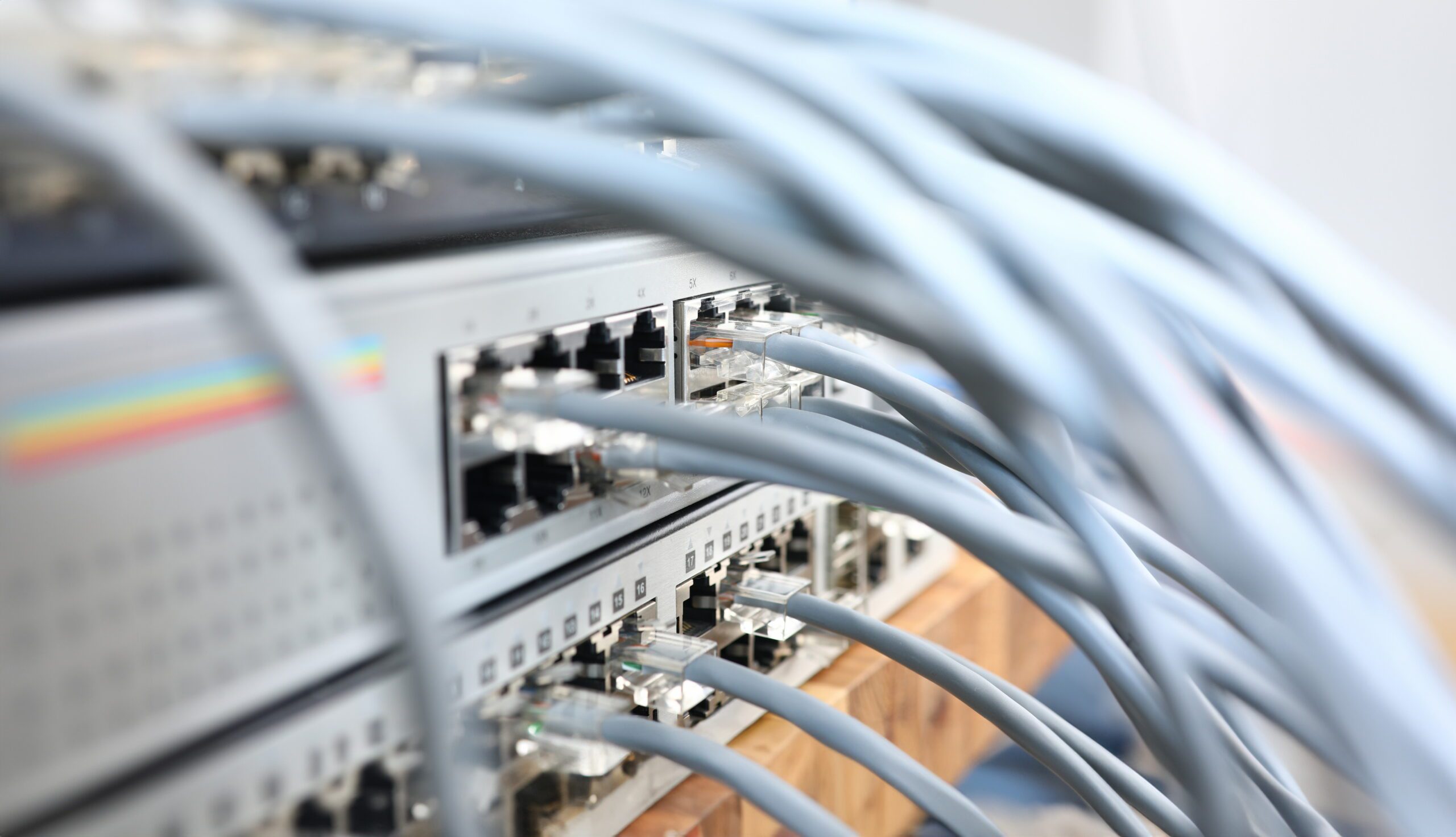
Cable Internet:
Widely available and relatively affordable, cable internet offers download speeds ranging from 25 Mbps to 500 Mbps. Popular providers include Comcast Business Internet, Spectrum Business Internet®, and Cox Business. Download speeds are typically faster than upload speeds, which can be a drawback for businesses that upload large files frequently. It’s widely available and typically more affordable than fiber, but speeds can fluctuate during peak hours and upload speeds may be lower.
Digital Subscriber Line (DSL):
A mature technology often available in areas where fiber and cable are not, DSL delivers speeds ranging from 10 Mbps to 100 Mbps. DSL utilizes existing telephone lines to deliver internet, making it readily available in most areas. While affordable, upload speeds are significantly slower than download speeds, making it less suitable for real-time applications like video conferencing. CenturyLink Business and Frontier Business are reputable DSL providers. DSL is a budget-friendly option for businesses with low-bandwidth needs.
Satellite Internet:
For businesses in remote locations with limited access to other options, satellite internet provides a lifeline. A viable option for rural businesses, satellite internet provides download speeds typically ranging from 10 Mbps to 25 Mbps. Upload speeds are much slower, and latency (data transmission delay) can be high, impacting video conferencing and online gaming. Additionally, data caps and weather-related outages can be concerns. Viasat Business and HughesNet are major satellite internet providers.
Fixed Wireless:
A newer option, fixed wireless internet utilizes cell towers to deliver broadband speeds ranging from 25 Mbps to 100 Mbps. Availability is expanding, particularly in underserved areas. T-Mobile Business Internet and Verizon 5G Business Internet are prominent players in this space. Providers like T-Mobile offer plans with speeds up to 100 Mbps, making it a viable alternative in areas with poor cable or DSL coverage. However, availability is limited, and speeds can be affected by weather and terrain.
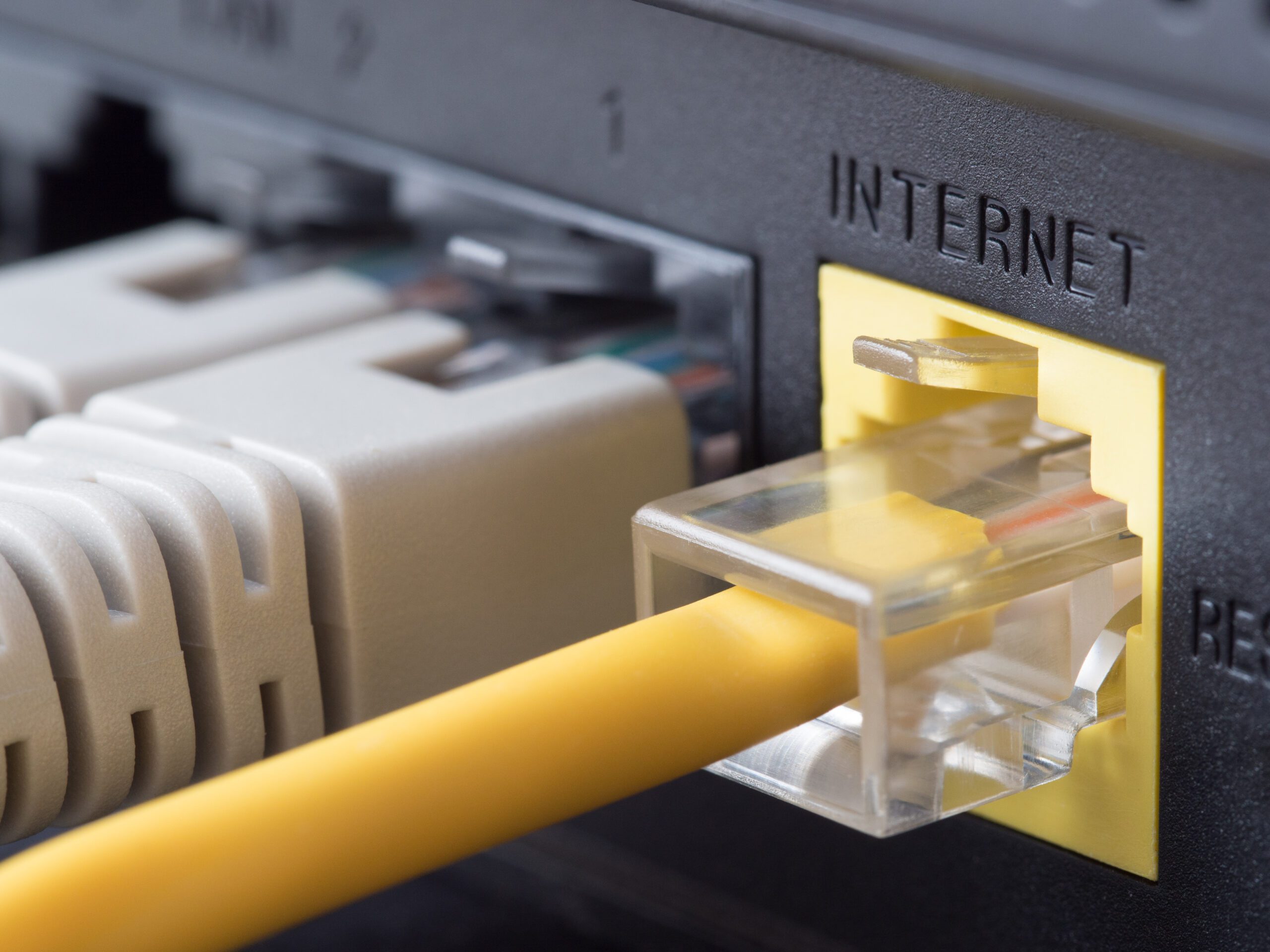
Considerations Beyond Speed
-
- Data Caps: Some providers, particularly cable and DSL, impose data caps, limiting your monthly data usage and potentially incurring additional charges.
- Cost: Pricing varies widely depending on connection type, speed, and bundled services. Always compare plans and factor in potential installation fees.
- Reliability and Customer Service: Research a provider’s reputation for network uptime, responsiveness to outages, and overall customer service quality.
- Additional Services: Many providers offer business-specific features like static IP addresses, managed network security, and dedicated customer support. Evaluate your needs and choose a provider that caters to them.
Top Providers and Considerations
Unite Private Networks (UPN): Provides fiber-optic communications infrastructure services to schools, governments, carriers, data centers, hospitals, and enterprise business customers.
-
-
- Service offerings include:
-
- dark and lit fiber,
- private line,
- optical Ethernet,
- FiberVoice,
- DDoS Protection, Cloud Connect, SD-WAN, and other customized solutions.
-
- UPN currently serves over 300 communities across 21 states, with 12,000 fiber route miles and 9,500 end customer sites.
- Provides excellent customer service.
- Service offerings include:
-
AT&T Business: Offers a variety of fiber and DSL plans, along with advanced features like static IP addresses and managed network services.
-
-
- DSL: AT&T Business offers Digital Subscriber Line (DSL) connections suitable for small businesses. DSL provides reliable internet access with moderate speeds.
- Fiber Optic: AT&T’s Fiber Internet is known for its high-speed and low latency, making it a great choice for data-intensive operations.
- Dedicated Internet: For businesses that require guaranteed bandwidth and high reliability, AT&T offers Dedicated Internet Access (DIA) services.
-
Comcast Business: Provides widespread cable internet coverage and offers bundled packages with phone and TV services.
-
-
- Cable Internet: Comcast Business offers high-speed cable internet connections with speeds ranging from 25 Mbps to 1 Gbps. It’s an excellent option for small to medium-sized businesses.
- Fiber Internet: Fiber-optic internet provides blazing fast speeds, and Comcast offers Gigabit Pro, which delivers up to 2 Gbps for larger enterprises.
- Ethernet: Comcast Business provides Ethernet services for businesses that require dedicated and symmetrical internet connections with high reliability.
-
Spectrum Business: Known for competitive pricing and reliable cable internet service in many areas.
-
-
- Spectrum Internet: Spectrum offers cable internet with speeds starting from 100 Mbps and going up to 940 Mbps, suitable for a wide range of businesses.
- Fiber Internet: Spectrum Fiber Internet provides symmetrical and reliable gigabit-speed connections for businesses with high bandwidth requirements.
-
Verizon Business: Offers fiber and DSL options, along with 5G business internet in select markets.
-
-
- Fios Business Internet: Verizon’s Fios offers fiber-optic internet with speeds ranging from 75 Mbps to 940 Mbps, ideal for small and medium-sized businesses.
- Ethernet Services: Verizon Business provides scalable Ethernet services, including Ethernet Private Line (EPL) and Ethernet Virtual Private Line (EVPL) for larger enterprises.
- 5G Business Internet: Verizon offers 5G connectivity for businesses in select areas, promising high-speed wireless internet with low latency.
-
Cox Business: Offers a variety of internet plans, including cable and fiber options, with speeds ranging from 25 Mbps to 10 Gbps.
-
-
- Managed Internet: For businesses looking for a fully managed internet solution, Cox provides Managed Internet Service with dedicated support.
-
Frontier Business: Offers business internet services with various speed options, including DSL and fiber, tailored to the needs of small and medium-sized businesses.
-
-
- Ethernet Solutions: Frontier’s Ethernet services provide dedicated and scalable connections for larger enterprises.
-
Google Fiber: Limited availability, but offers the fastest speeds and symmetrical upload and download.
Beyond the Basics
Once you’ve chosen a connection type and provider, consider additional factors like:
- Scalability: Can the plan grow with your business needs?
- Security: Does the provider offer robust security features to protect your data?
- Managed Services: Do you need additional support for network management and maintenance? Or even to assist you in determining exactly what your business internet needs are?
It is important to know the speed ability of the car you have (your office technology), and what the road is like that you want to drive on (internet and ISP options, with consideration for the list below).
You don’t want to put your Lamborghini on that dirt road! This is where PCA can consult with your business and be your technology coach and help you choose the best options for your business.
Additional details to consider when choosing an internet service provider (ISP) for your business:
-
-
- Shared vs. dedicated internet
- Symmetrical vs. asymmetrical speeds
- Latency
- Jitter
- Service Level Agreements vs. Best Effort Internet services
-
The Bottom Line
Choosing the right internet service for your business requires careful consideration of your specific needs and budget.
Weigh factors like speed, reliability, data caps, cost, scalability, security, shared vs. dedicated internet, and additional services to make an informed decision. And don’t hesitate to ask for recommendations from other businesses in your area.
Remember, the fastest or most expensive option isn’t always the best; the ideal internet connection seamlessly integrates with your operations and supports your business growth.
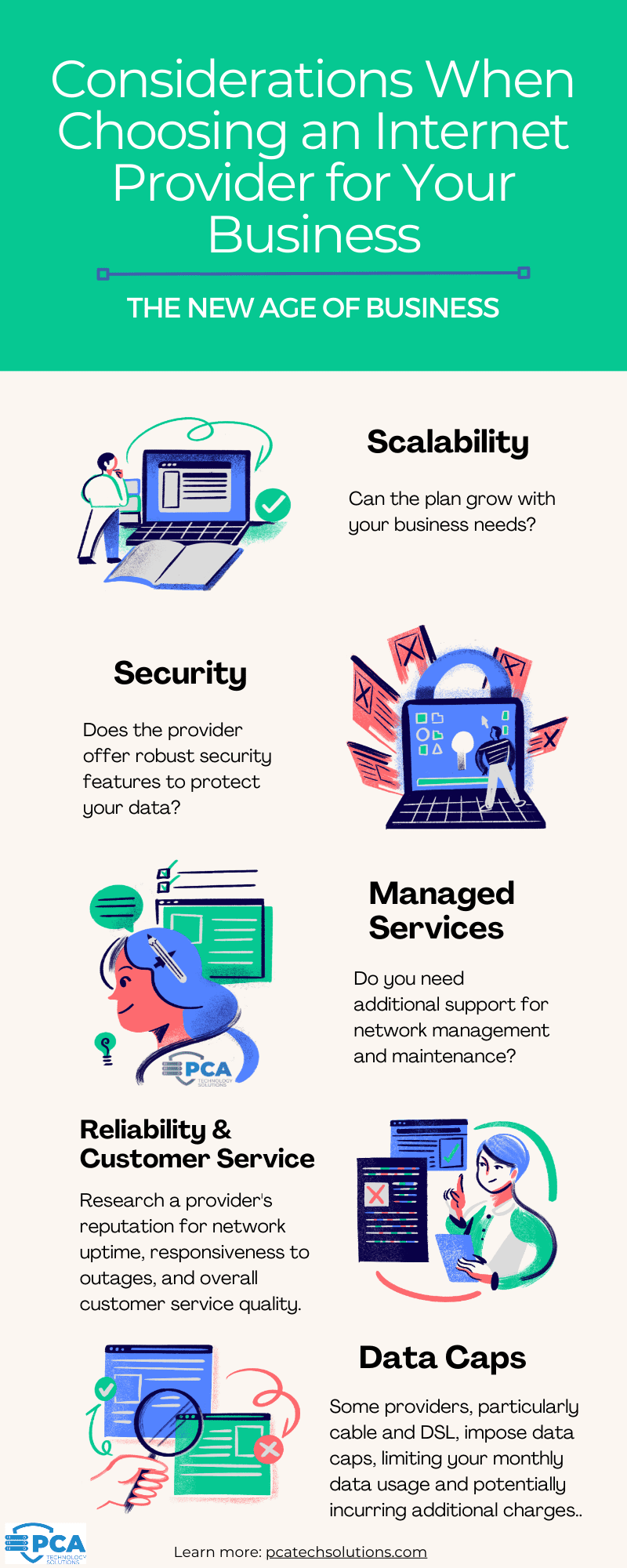
Bonus Tip:
Explore government programs and initiatives that offer subsidized internet access for eligible businesses.
Additional Resources:
We hope this guide provides a valuable starting point for your research. Remember, the best internet provider for your business is the one that fits your unique needs and helps you thrive in the digital world.
As you look into the new year and are considering your business growth plans, we recommend you look at your internet service provider and whether or not your current plan will be right for your growth needs.
“You are only as strong as your weakest link.”
I always try to find a way to include this quote when referencing things in IT, including about the internet. Using a variety of ways to explain technology so it is more easily understood is a big part of being a great technology coach. That is what we specialize in at PCA Technology Solutions.
Your Coach helping you drive the internet,
Tony Fry, Director of Innovative Technology
Need help?
At PCA Technology Solutions, we work hard every day to take care of our clients to make managing your business a little bit easier on you. Contact us today to ask how we can help your business.

Tony Fry
Director of Innovative Solutions, PCA Technology Solutions
Tony Fry is the Director of Innovative Solutions at PCA Technology Solutions, where he has been a dedicated employee since 1998. With over two decades of experience in the industry, Tony specializes in the strategic review and seamless implementation of cutting-edge IT solutions. His expertise lies in identifying innovative technologies and translating them into practical applications that drive efficiency and growth for businesses. Tony’s forward-thinking approach and deep understanding of IT infrastructure make him an invaluable asset in navigating the ever-evolving landscape of technology. Passionate about leveraging technology to solve complex challenges, Tony is committed to driving impactful and transformative solutions for PCA Technology Solutions and its clients.

Windows 10 End of Life: Make the Smart Move Now
By October 14, 2025, Windows 10 will reach its end of life, and if that doesn't concern you, it should. No more updates, no more support, and no protection from evolving cyber threats. For businesses, this isn't just a tech problem; it's a security, productivity, and...

Unlock the Harsh Truth About Data Breach: Can you Afford It?
Data breaches are no longer just a concern for giant enterprises; they're a growing threat to small and mid-sized businesses across all industries too! One moment, your team is busy handling operations, and the next, your systems are down, customer data is...

Enhanced Security with Remote Monitoring and Management
In today's digital world, the line between convenience and vulnerability has become incredibly thin. Businesses of all sizes (yes, even small ones) face growing cybersecurity threats every day. From ransomware to phishing attacks, no company is immune. That's where...

What’s New in MS Teams: 10 Must Know 2025 Features
Microsoft Teams has rolled out a suite of updates in 2025, designed to enhance user experience and workplace efficiency. These changes, based on valuable user feedback, help streamline workflows, improve communications, and make everyday tasks feel more seamless. ...
